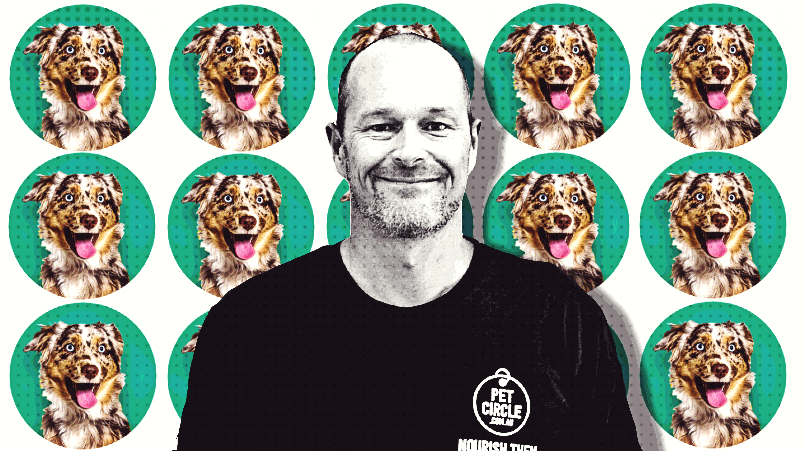Convincing ‘spooked’ VCs to see past ‘flawed’ digital metrics, perverse performance and fake ROI: How Pet Circle CMO is turning the tide, winning brand budget
An Mi3 editorial series brought to you by
The Future of TV Advertising Forum and Mi3


Slipping the leash: Pet Circle CMO Jon Wild is testing hard to find proof-points and rules that underline why brand investment ultimately delivers growth. Now his VC backers and the CFO are starting to believe.
As the CMO of Australia's top five online retailers with revenues upwards of $400m, Pet Circle's Jon Wild until last year had 24 months to achieve ROI on acquiring customers through media and beyond. But then capital markets went south and venture capital firms, including Pet Circle's backers, pulled in their horns. "They're spooked," said Wild. Now he has 12 months max to deliver acquisition ROI, creating a perverse incentive to go lower funnel and cheap. But the approach and metrics are wrong, per Wild. So he's been testing hard and found that investing in brand delivers double duty: "For every five points of awareness, we get up to 10 per cent improvement in our performance media," said Wild. Now the CFO and the VCs are starting to believe. Question is, will they double his budget?
What you need to know:
- Online pure-play Pet Circle has circa 500,000 customers and upwards of $400m in revenue. It wants growth, but cooler climes in capital markets have “spooked” its VC backers.
- They’ve tasked CMO Jon Wild with halving payback periods on customer acquisition from 24 months to 12.
- That’s creating pressure to blow most of the budget in lower funnel performance channels, which on paper looks good. But the metrics are “flawed” per Wild, and the customers acquired would probably have bought anyway.
- So he’s testing hard to convince the bean counters to back brand. Early data shows strong correlation between investment in awareness and improved performance.
- Wild said the money men are starting to listen.
The CFO, C-suite, the VCs, they want to hear that you're using data and you're effective and responsible with it. You may have the wrong answer – you probably do most of the time – but the process of it gives them confidence. They get [more] confidence in you the more you talk their language.
Wild thing
Jon Wild is CMO at Pet Circle, a VC-backed top five online Australian ecom pure-play with 500,000-plus customers and revenues upwards of $400m. In the 12 years since launch, it has notched massive growth. But the firm of late is under pressure from VC backers to halve the payback period on customer acquisition.
That requirement forces marketers to chase the most efficient targets at the bottom of the funnel – they are the cheapest buys, at least according to “flawed” digital metrics. Wild knows that’s a waste – because those customers were probably going to buy anyway.
So he’s going all out to prove brand investment delivers double duty: genuine longer-term growth and short-term sales.
Funnelling money
The early results are promising. Pet Circle’s latest data shows that “for every five points of awareness, we get up to 10 per cent improvement in our performance media,” Wild told last month’s Future of TV Advertising conference. “That gives me a model or a metric to then start saying, ‘right, we need to invest up the funnel – even though you're not going to see the 12 month payback'.”
Before the capital market crunch last year, there was more ROI leeway. “We were on 24 months and they're saying ‘spend, spend, spend’. Now we have to pay back that customer within 12 months, but average customer tenure is eight years,” said Wild. “It's a crazy model in that sense. The VCs are spooked. They're preserving capital. The cost of capital has gone up. And one way they constrain it is by shrinking your paybacks.”
That runs counter to what the VCs actually want – i.e. growth so they can ultimately exit with a decent multiple, creating perverse incentives, per Wild.
“Your immediate reaction is to go down the funnel. But you know that's the wrong approach – you end up talking to the same customers and the ones that are most efficient are probably already existing. It's very hard to then create new customers to your business. But [the VC backers] have still got the growth agenda, so they're trying to have their cake and eat it.”
Wild and his team are trying to prove that’s a mistake – and the proof-points to change minds.
“It’s a testing culture, and you try and create confidence in what you're doing through using data. So we share a monthly report with our VCs on our marketing, we show everything under the covers, there's nothing to hide,” he said.
“We will always hold out a market, and then we progressively test, moving up the funnel to try and find something that grips.”
Which is how Pet Circle hit on the five points awareness, 10 per cent performance improvement formula. But to keep proving it out, using media mixed models and the like, “requires a lot of data, a lot of time and a lot of investment to get really effective and robust [results],” per Wild.
Slowly though, it is starting to turn the tide.
Building bridges
“We’re now working with this assumption that we need to go up the funnel. We have a belief that awareness, consideration, mental availability and all that stuff will drive our long-term business growth. We've got consensus on that. So we're trying to build tests, but also business rules to correct imperfect markets: the digital market is imperfect, it gives you the wrong answer. We know it's wrong, we just don't know how flawed it is,” said Wild.
As an example of flawed digital metrics, he cites acquiring a customer based on cost per acquisition [CPA] that may buy a novelty pet toy once, but never buy anything again.
“What we need are food customers. They're the ones that have great LTVs [lifetime value]. But if I focus on that one metric, while the optics look good, the business value is really poor.”
Despite capital constraints, that argument is starting to land.
“We now have an agreement where as our proportion of marketing spend per revenue goes up, we will apply most of the incremental [spend] to the upper funnel. You can’t keep stuffing it down the bottom of the funnel, because you're just hitting the same customers over and over again.”
The testing, he underlined, has been critical in getting to that point.
“The CFO, C-suite, the VCs, they want to hear that you're using data and you're effective and responsible with it. You may have the wrong answer – you probably do most of the time – but the process of it gives them confidence. They get [more] confidence in you the more you talk their language.”
Wild is hoping that the results ultimately give the beancounters sufficient faith to significantly increase his overall budget, which currently sits at “four to five per cent” of its revenues, he said. “But it should be ten per cent”.
Either way, he's inching upstream.
"We know we need to move from demand harvesting to demand generation. We're predominantly demand harvesting right now. But all of our focus is on figuring out a playbook or go to market method that allows us to move systematically up the funnel."
